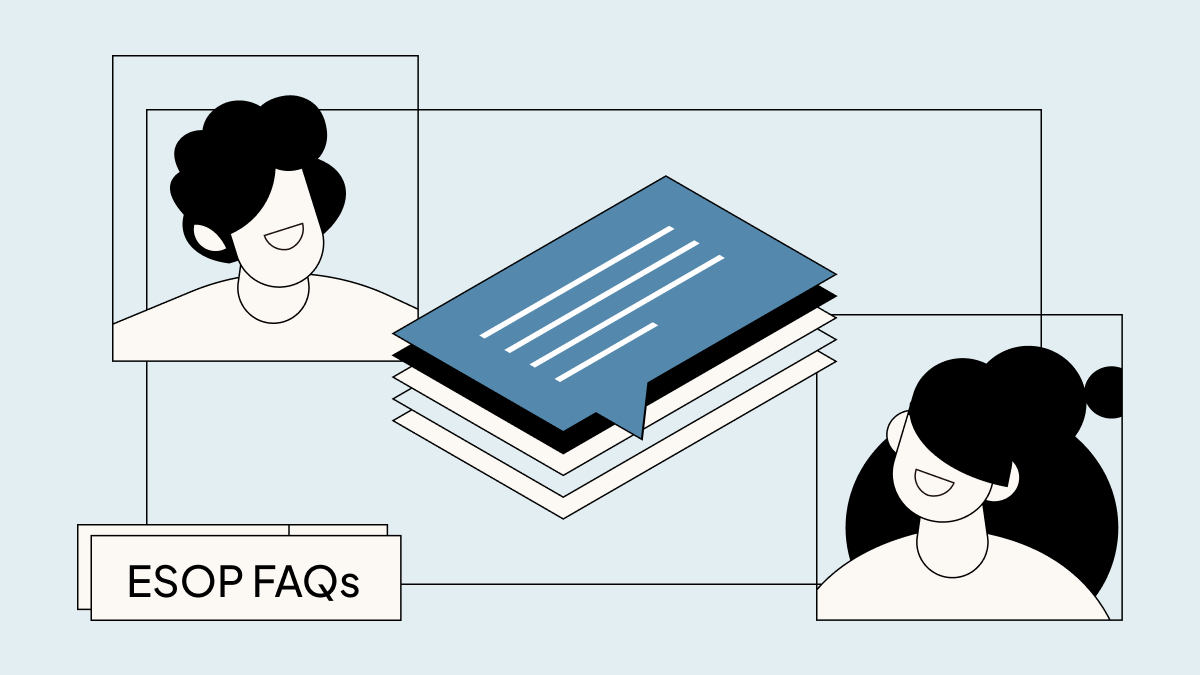If you’re wondering what an ESOP is and how it works, you’ve come to the right place. Even if you're familiar with employee share schemes, you might be in a position of explaining the finer details to colleagues who work with – or have been granted – private company equity. This article will answer some of the most common questions on ESOPs.
What is an ESOP?
ESOP stands for “employee stock ownership plan” (or “employee share ownership plan” in some countries). Setting up an ESOP allows companies to offer contributors – such as employees, contractors and advisors – an equity stake in the business.
The term “ESOP” is also used in the UK, Europe and Australia to refer to employee share option schemes and employee share option plans.
How does an ESOP work?
ESOPs can work differently depending on where a company and its employees are based.
ESOP trust
In the US, employee stock ownership plans can be implemented through a trust structure that holds shares in the company and allows employees to purchase, or be granted, shares in the trust. ESOPs can be used to protect the succession of a business or provide employees with a retirement fund. When they leave or retire, the employee can cash out the shares in their trust account for the equivalent monetary value. If the company is sold before then, they would receive a payout based on the number of vested shares they own.
A similar scheme available in the UK is an Employee Ownership Trust (EOT). Although the shares are held by the EOT trustee rather than in individual funds or accounts, employees would still be entitled to participate in the proceeds from a company sale.
Employee share option scheme
Share options give employees the right to buy a set number of shares in the future for a predetermined strike price (or exercise price). Before receiving their equity, the grantholder must review and sign an option agreement. This contract specifies the terms and conditions of the grant, including the vesting schedule, exercise window and relevant leaver clauses.
A typical option grant has a four-year vesting period with a one-year cliff. There won’t be any vested options until the cliff, so it’s in an employee’s interests to stay at the company for at least a year. Time-based vesting conditions like this are intended to reward loyalty, as employees generally contribute more value to a business the longer they work there.
However, vesting alone doesn’t guarantee ownership. The employee needs to exercise their vested options – under the conditions outlined in the grant agreement – to turn them into actual company shares.
What are the benefits of an ESOP?
The main benefit of ESOPs is the potential for long-term financial gain. By allowing employees to participate in the future success of a business, ESOPs can be used to attract talent, incentivise performance and ensure that individuals are aligned on company goals.
ESOPs are usually “qualified” or “approved”, which means that there are tax benefits for both the employer and the employee. The taxation of ESOPs varies for different equity schemes and tax jurisdictions.
The most popular government-approved share scheme in the UK is the EMI scheme. There are no tax implications or National Insurance Contributions (NIC) for employees or employers when granting EMI options, and employees only pay capital gains tax (at a reduced rate of 10%) when they sell their shares. For companies that aren’t eligible for EMI, alternative equity schemes in the UK include CSOP, SIP and SAYE.
What is the value of ESOP shares?
As with actual company shares, the value of share options is typically determined by the most recent company valuation. For share schemes like EMI and CSOP, startups need to get their valuation approved by HMRC before issuing share options.
The value of share options increases relative to the value of the company. The more the company is worth when it reaches a liquidity event (or invites equity holders to take part in a secondary transaction), the more employees seek to gain by selling their shares.
Employees help to drive business performance, so it’s worth making this link apparent when explaining how equity awards work. When a business is doing well, more investors want a slice of the pie, which boosts the value of the company and its shares – it’s a win-win situation.
What happens when an employee leaves the company?
When it comes to equity, what happens when an employee leaves depends on whether they’re a ‘good leaver’ or a ‘bad leaver’. Leaver clauses are defined by each company and set out in the relevant share plan documents – such as EMI share plan rules. Typically, ‘good leavers’ are allowed to retain any vested share options, whereas ‘bad leavers’ often lose this right. In some cases, all of an employee’s options – whether vested or unvested – lapse upon termination and return to the company’s option pool.
The next steps vary between companies and share schemes. Some give employees a set window to exercise their share options before they expire or no longer qualify for tax advantages, while others are more flexible. In fact, industry norms range from 90 days to ten years. There’s always a risk to exercising options as a leaver, as there’s no guarantee they’ll be able to sell the shares and cash out. It’s recommended to seek independent financial or legal advice before making this decision.
When can employees expect a return on their equity?
ESOP payouts are based on a future exit event – such as an IPO, merger or acquisition – or a secondary transaction. Until then, the share options are not “liquid”, which means that employees can’t cash out until their equity has vested, been exercised and then sold. Even then, there’s no guarantee they’ll make a profit – it all depends on how successful the business is.
To incentivise employees, it’s helpful to explain the various scenarios that could impact the value of their equity:
-
If the business is a huge success, employees may be able to sell their shares at a high valuation and make a significant profit.
-
If the business performs moderately well, there’s a reasonable chance that employees can gain from a liquidity event.
-
If the company shuts down or sells for a lower valuation than the options were issued at, the equity will be worth nothing.




